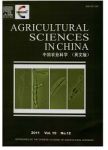Nitrogen release and re-adsorption dynamics on crop straw residue during straw decomposition in an Alfisol
Nitrogen release and re-adsorption dynamics on crop straw residue during straw decomposition in an Alfisol作者机构:Engineering Research Center of Ecology and Agricultural Use of WetlandMinistry of Education/College of AgricultureYangtze UniversityJingzhou 434025P.R.China
出 版 物:《Journal of Integrative Agriculture》 (农业科学学报(英文版))
年 卷 期:2021年第20卷第1期
页 面:248-259页
核心收录:
学科分类:09[农学] 0903[农学-农业资源与环境] 090301[农学-土壤学]
基 金:supported by the National Key Research & Development Program of China (2018YFD0200900) the Young and Middle-Aged Talents Project of Hubei Provincial Department of Education, China (Q20181303) the Open Fund of Key Laboratory of Fertilizer Utilization, Ministry of Agriculture and Rural Affairs, China (KLFAW201901)
主 题:adsorption decomposition nitrogen(N) Alfisol straw substrate
摘 要:Returning crop straw to the field not only improves the nitrogen(N) supplying capacity and N retention of soil but also decreases the amount of rural organic waste and prevents air pollution. Therefore, understanding the mechanisms of the N release and re-adsorption dynamics on crop straw residue during straw decomposition in agricultural soil is important, and this understanding can help us strengthen N fertilizer management during the crop growth period. An on-farm incubation experiment was conducted in the Jianghan Plain in Central China under flooded conditions using the nylon mesh bag method. Results showed that the decomposition rate of crop straw was much faster at the beginning of the incubation stage, whereas it was steady during the later stage with no observed differences among the three types of crop straw. After 120 d of incubation, the cumulative decomposition proportion of rice straw, wheat straw and rape straw was 72.9, 56.2, and 66.9%, respectively. The proportion of N that released from the three crop straws was 52.0, 54.4 and 54.9%, respectively. The zeta potentials and Brunauer, Emmett and Teller(BET) surface area of the rice, wheat and rape straw residues increased gradually as the decomposition period progressed. The water adsorption capacity of the rice straw was significantly affected during the decomposition period. The saturated water adsorption capacity of rice straw was the highest at 30 d of decomposition(4.17 g g^–1) and then decreased slightly. The saturated water adsorption of wheat and rape straws reached the lowest value at 30 d and then gradually increased and became stable. All the results demonstrated that crop straw and straw residue can re-adsorb NH4^+ ions from the surrounding solution. The re-adsorption was affected by the decomposition period and concentration of exogenous NH4^+ and was independent of the crop species via the combined efforts of physical and chemical adsorption, ion exchange and water retention on residue su



